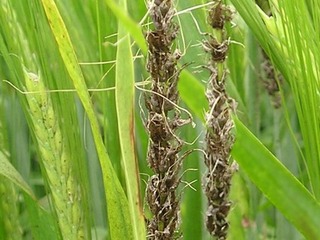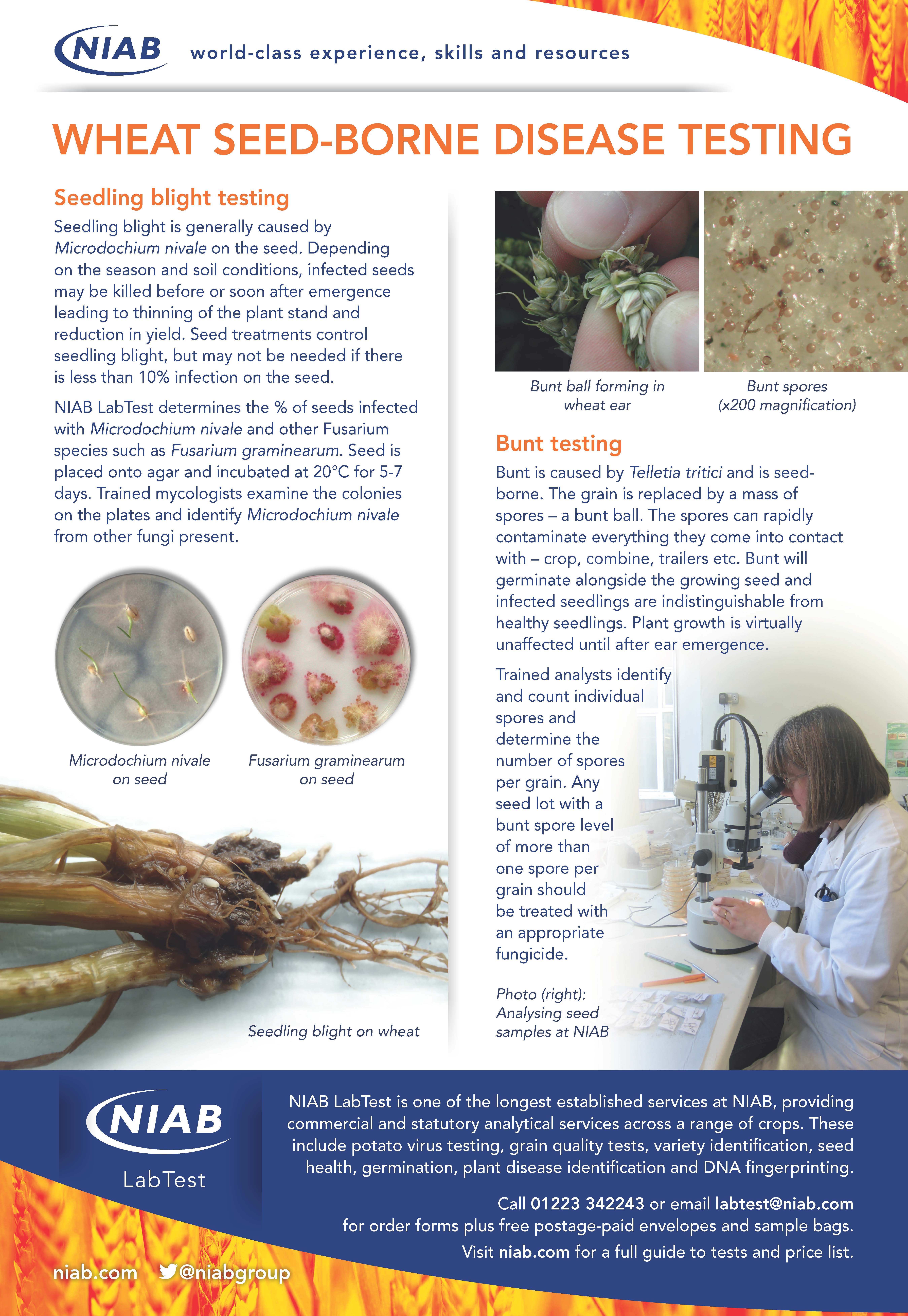
Seed-borne pathogens represent a major threat to crop establishment and yield.
Traditionally such diseases have been controlled through the use of a range of effective chemical applications. However the increasing drive towards sustainable agriculture with an emphasis on “treatment according to need” and organic production has increasingly lead to the sowing of untreated seed. The seed pathology laboratories at NIAB offer a range of tests for the most common seed-borne pathogens.
CEREALS
Download our 'wheat seed-borne disease testing' information poster used at events and shows
Microdochium seedling blight
Microdochium seedling blight on wheat is caused by Microdochium nivale (formally known as Fusarium nivale). Seedling blight is invariably caused by fungi carried on the seed and can affect seed vigour and performance. Depending on the season and soil conditions, infected seedlings may be killed before or soon after emergence. Plant establishment can be very poor and may lead to a reduction in grain yield.
Our test requires trained mycologists to distinguish Microdochium nivale from other fungi present with results given as the percentage of seed infected and takes 5-7 days. NIAB advises that seed lots with infection levels below 10% do not require a seed treatment. Above 20% infection, growers should consider product choice and likely sowing conditions very carefully.
Leaf Stripe and Net Blotch
Leaf stripe on barley is caused by the fungus Pyrenophora graminea. This is a highly infectious seed-borne pathogen, found in the seed coat of the seed. The disease symptoms are very characteristic: long stripes developing on the leaves, often running the entire length of the leaf, pale green at first then yellow, and finally brown in colour. All or most of the leaves on an affected plant show these symptoms and some may split along the infected stripes giving them a shredded appearance. Infected plants may die before ear emergence, or survive to produce small ears with few grains. Spores from diseased plants infect the ears of healthy neighbouring plants. Due to the seriousness of leaf stripe NIAB recommends that any seed-lots containing infection is treated.
Net blotch caused by Pyrenophora teres is very closely related to leaf stripe. However, seed-borne infection by this pathogen is of much lower importance as the majority of the disease in the field results from infection spreading from debris from previous crops. As a result a low level of net blotch can be tolerated in a seed lot.
Our rapid PCR test for leaf stripe and net blotch takes 2 days.
Loose Smut
Loose smut on barley is caused by Ustilago nuda. The infected plant is almost indistinguishable from a healthy plant. The first sign of disease is seen as the ear emerges revealing the typical sooty spore mass which replaces the grain. These spores blow onto healthy ears at flowering time and invade the developing grain.
Our test requires a trained mycologist examines embryos for infection and takes 2-3 days. Results are given as the percentage of seed infected.
Bunt
Bunt on wheat is caused by Tilletia caries. The grain is replaced by “bunt balls” - masses of fishy-smelling brown spores which can rapidly contaminate the crop, combine, trailers, cleaning gear and sacks. The fungal spores adhere to the seed coat and after infection the fungus grows up within the emerging seedling. The infected seedlings are indistinguishable from healthy seedlings since their growth is virtually unaffected until after ear emergence. Even a low level of infection can render the crop unfit for milling purposes.
Our test requires a trained mycologist to identify and count fungal spores with results given as spores per grain and takes 2-3 day. NIAB advises that any seed lot with a bunt spore level greater than 1 spore per grain should be treated with an appropriate fungicide.
PULSES
Ascochyta Leaf and Pod Spot
Ascochyta leaf and pod spot is caused by Ascochyta fabae, which is carried in the seed coat of the seed. Initial symptoms are seen on the young leaves of seedlings growing from infected seed, spots are up to 1cm long, with a chestnut brown edge. In severe attacks plants can be defoliated and pods become covered in lesions. Seeds from infected pods may be stained by the pathogen, although not all infected seed is marked in this way.
Our test requires a trained mycologist to identify the Ascochyta and takes 7-8 days. The result is reported as the percentage of the seed infected. NIAB recommends that seed with an infection of more than 1% should be treated and those above 6% should not be used at all.
Stem Nematodes
The stem nematode, Ditylenchus dipsaci and Ditylenchus gigas, is a damaging pest of field beans. Infested plants often show little in the way of symptoms, but may have distorted stems and necrotic areas on leaves. Infection by stem nematodes can affect yields, with heavy infestation causing losses of up to 50%. Two races of stem nematodes commonly occur called the oat-onion race and the more devastating giant race.
Our test requires a trained analyst to identify the nematodes and takes 2-3 days. NIAB advises that infected seed should not be used, to avoid spread of the nematode to un-infested land. As a result our test reports either the presence or absence of stem nematode in the sample with a guide to the level of infestation. The nematode race present can be identified on request.
Free Living Nematodes
NIAB offers to identify and count free-living nematode (FLN) species from soil samples that specifically affect potatoes, umbelliferae, cereals, beet or alliums. The FLN species that affect potatoes are:
- Stubby root nematode (Trichodorus): Does not usually damage tubers directly, however it the vector for Tobacco Rattle Virus (TRV), one of the causative agents of spraing.
- Needle nematode (Longidorus): When present, will feed on growing root tips and form galls.
- Root Lesion nematode (Pratylenchus): High populations cause reduced growth, yellowing and smaller tubers, and also cause lesions on both the roots and tubers.
- Root Knot nematode (Meloidogyne): Although rarer than the others, causes blemishes on tubers affecting appearance and cooking quality.
- Stem nematode (Ditylenchus): Occasionally attacks tubers causing conical pits with skin splitting.
- Potato Cyst Nematode juveniles (Heterodera and Globodera): A serious problem for potatoes grown in the UK. PCN cause yellowing and wilting of the plants and often result in premature death.
In most cases, the degree of loss depends on the nematode species, population density and the host cultivar, along with local climatic conditions.
Our test will provide you with the population density, and a breakdown of the FLN species present in your soil. We strongly suggest further testing for PCN to provide a full assessment of any problem; similarly, if stubby root nematodes are present a TRV test should be performed.
Potato Cyst Nematodes
Potato Cyst Nematodes (PCN) are endoparasites that cause decreased crop yields. Two species of PCN - Globodera pallida and Globodera rostochiensis exist in the UK, often in mixed populations. Affected plants exhibit symptoms that are similar to those of water stress or mineral deficiency - yellow appearance, wilting at midday and premature death.
At NIAB we perform two tests for PCN in soil and these are recommended for those intending on planting all varieties of potato. The first is based on either an estimate or actual count of cyst egg larvae, and a value of cysts per kg of soil will be reported. This test will take 7-10 days. Alternatively we have a molecular DNA-based test that will identify the species of PCN (if cysts are supplied the test will only take three days).
For more information contact Helen Appleyard
